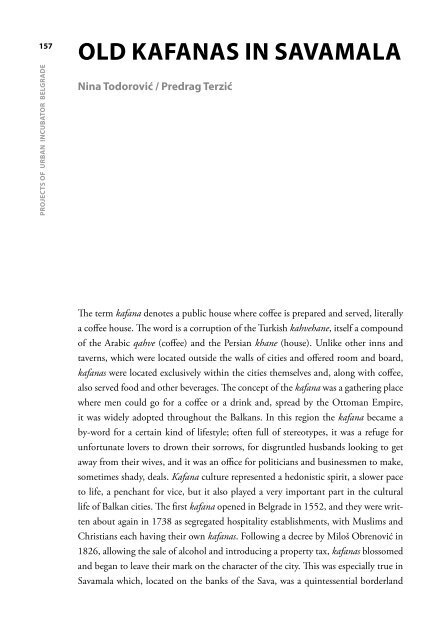Bureau Savamala Belgrade
978-3-86859-359-4
978-3-86859-359-4
You also want an ePaper? Increase the reach of your titles
YUMPU automatically turns print PDFs into web optimized ePapers that Google loves.
157<br />
Projects of urban Incubator <strong>Belgrade</strong><br />
Old Kafanas in <strong>Savamala</strong><br />
Nina Todorović / Predrag Terzić<br />
The term kafana denotes a public house where coffee is prepared and served, literally<br />
a coffee house. The word is a corruption of the Turkish kahvehane, itself a compound<br />
of the Arabic qahve (coffee) and the Persian khane (house). Unlike other inns and<br />
taverns, which were located outside the walls of cities and offered room and board,<br />
kafanas were located exclusively within the cities themselves and, along with coffee,<br />
also served food and other beverages. The concept of the kafana was a gathering place<br />
where men could go for a coffee or a drink and, spread by the Ottoman Empire,<br />
it was widely adopted throughout the Balkans. In this region the kafana became a<br />
by-word for a certain kind of lifestyle; often full of stereotypes, it was a refuge for<br />
unfortunate lovers to drown their sorrows, for disgruntled husbands looking to get<br />
away from their wives, and it was an office for politicians and businessmen to make,<br />
sometimes shady, deals. Kafana culture represented a hedonistic spirit, a slower pace<br />
to life, a penchant for vice, but it also played a very important part in the cultural<br />
life of Balkan cities. The first kafana opened in <strong>Belgrade</strong> in 1552, and they were written<br />
about again in 1738 as segregated hospitality establishments, with Muslims and<br />
Christians each having their own kafanas. Following a decree by Miloš Obrenović in<br />
1826, allowing the sale of alcohol and introducing a property tax, kafanas blossomed<br />
and began to leave their mark on the character of the city. This was especially true in<br />
<strong>Savamala</strong> which, located on the banks of the Sava, was a quintessential borderland


















